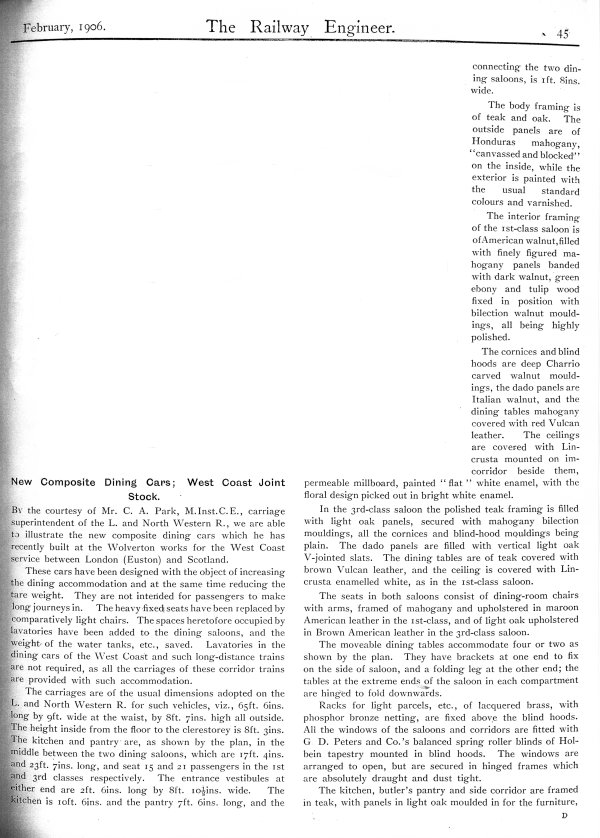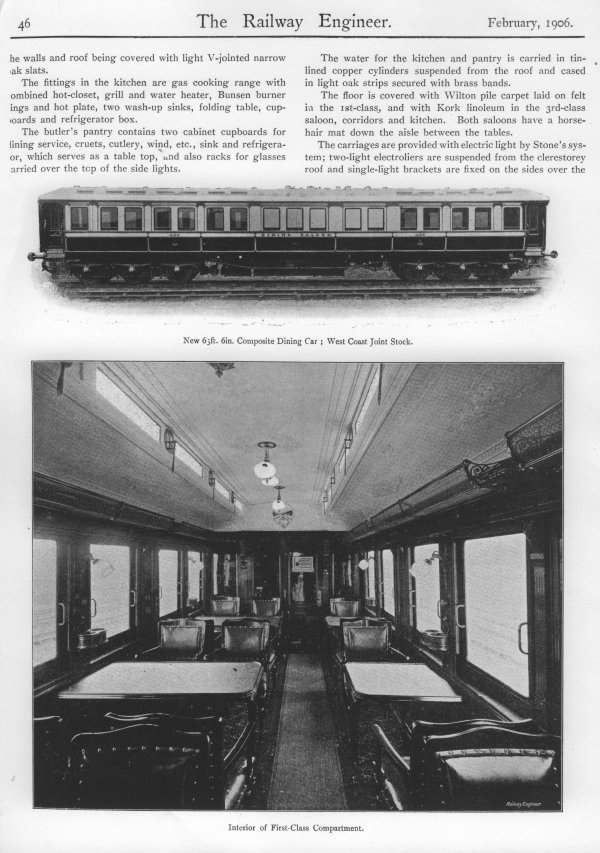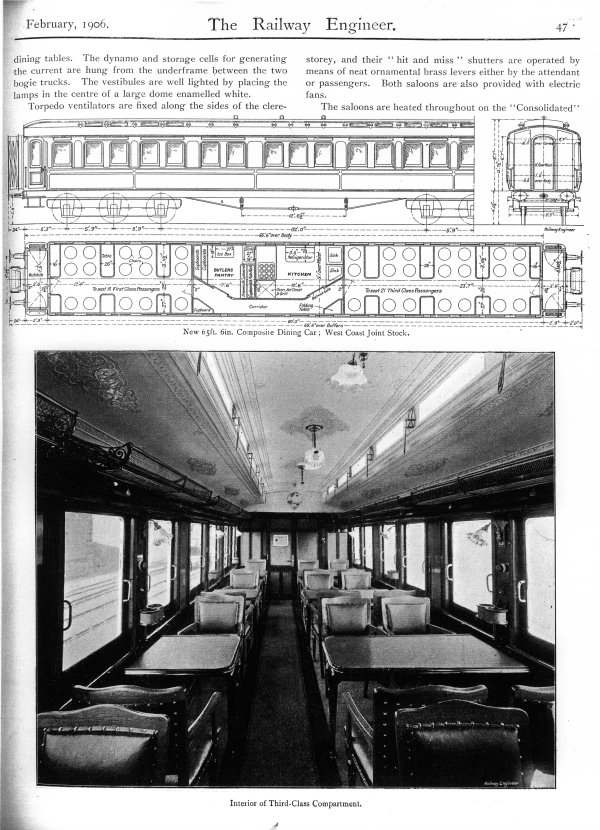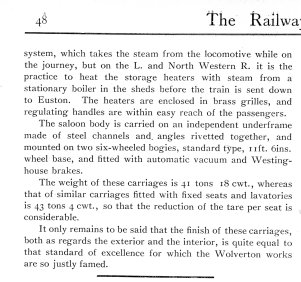New Composite Dining Cars; West Coast Joint Stock
The Railway Engineer, February 1906, pp45-48.

Transcription:
By the courtesy of Mr C A Park, M Inst C E, carriage superintendent of the L and North Western R, we are able to illustrate the new composite dining cars which he has recently built at the Wolverton works for the West Coast service between London (Euston) and Scotland.
These cars have been designed with the object of increasing the dining accomodation and at the same time reducing the tare weight. They are not intended for passengers to make long journeys in. The heavy fixed seats have been replaced by comparatively light chairs. The spaces heretofore occupied by lavatories have been added to the dining saloon, and the weight of the water tanks, etc., saved. Lavatories in the dining cars of the West Coast and such long-distance trains are not required, as all the carriages of these corridor trains are provided with such accommodation.
The carriages are of the usual dimensions adopted on the L and North Western R for such vehicles, viz., 65 ft 6 ins long by 9 ft wide at the waist, by 8 ft 7 ins high all outside. The height inside from the floor to the clerestorey is 8 ft 3 ins. The kitchen and pantry are, as shown by the plan, in the middle between the two dining saloons, which are 17 ft 4 ins and 23 ft 7 ins long, and seat 15 and 21 pssengers in the 1st ans 3rd classes respectively. The entrance vestibules at either end are 2 ft 6 ins long by 8 ft 10½ ins wide. The kitchen id 10 ft 6 ins and the pantry 7 ft 6 ins long, and the connecting the two dining saloons, is 1 ft 8 ins wide.
The body framing is of teak and oak. The outside panels are of Honduras mahogany, “canvassed and blocked” on the inside, while the exterior is painted with the usual standard colours and varnished.
The interior framing of the 1st-class saloon is of American walnut, filled with finely figured mahogany panels banded with dark walnut, green ebony and tulip wood fixed in position with bilection walnut mouldings, all being highly polished.
The cornices and blind hoods are deep Charrio carved walnut mouldings, the dado panels are Italian walnut, and the dining tables mahogany covered with red Vulcan leather. The ceilings are covered with Lincrusta mounted on imcorridor beside them, permeable millboard, painted “flat” white enamel, with the floral design picked out in bright white enamel.
In the 3rd-class saloon the polished teak framing is filled with light oak panels, secured with mahogany bilection mouldings, all the cornices and blind-hood mouldings being plain. The dado panels are filled with vertical light oak V-jointed slats. The dining tables are of teak covered with brown Vulcan leather, and the ceiling is covered with Lincrusta enamelled white, as in the 1st-class sloon.
The seats in both saloons consist of dining-room chairs with arms, framed of mahogany and upholstered in maroon American leather in the 1st-class, and of light oak upholstered in Brown American leather in the 3rd-class saloon.
The moveable dining tables accomodate four or two as shown by the plan. They have brackets at one end to fix on the side of saloon, and a folding leg at the other end; the tables at the extreme ends of the saloon in each compartment are hinged to fold downwards.
Racks for light parcels, etc., of lacquered brass, with phosphor bronze netting, are fixed above the blind hoods. All the windows of the saloons and corridors are fitted with G D Peters and Co’s balanced spring roller blinds of Holbein tapestry mounted in blind hoods. The windows are arranged to open, but are secured in hinged frames which are absolutely draught and dust tight.
The kitchen, butler’s pantry and side corridor are framed in teak, with panels in light oak moulded in for the furniture,

the walls and roof being covered with light V-jointed narrow oak slats.
The fittings in the kitchen are gas cooking range with combined hot-closet, grill and water heater, Bunsen burner rings and hot plate, two wash-up sinks, folding table, cupboards and refrigerator box.
The buter’s pantry contains two cabinet cupboards for dining service, cruets, cutlery, wind [wine?], etc., sink and refrigerator, which serves as a table top, and also racks for glasses carried over the top of the side lights.
The water for the kitchen and pantry is carried in tin-lined copper cylinders suspended from the roof and cased in light oak strips secured with brass bands.
The floor is covered with Wilton pile carpet laid on felt in the 1st-class, and with Kork linoleum in the 3rd-class saloon, corridors and kitchen. Both saloons have a horsehair mat down the aisle between the tables.
The carriages are provided with electric light by Stone’s system; two-light electroliers are suspended from the clerestorey roof and single-light brackets are fixed on the sides over the

dining tables. The dynamo and storage cells for generating the current ae hung from the underframe between the two bogie trucks. The vestibules are well lighted by placing the lamps in the centre of a large dome enamelled white.
Torpedo ventilators are fixed along the sides of the clerestorey, and their “hit and miss” shutters are operated by means of neat ornamental brass levers either by the attendant or passengers. Both saloons are also provided with electric fans.
The saloons are heated throughout on the “Consolidated”

system, which takes team from the locomotive while on the journey, but on the L and North Western R it is the practice to heat the storage heaters with steam from astationary boiler in the sheds before the train is sent down to Euston. The heaters are enclosed in brass grilles, and regulating handles are within easy reach of the passengers.
The saloon body is carried on an independent underframe made of steel channels and angles rivited together, and mounted on two six-wheeled bogies, standard type, 11 ft 6 ins wheel base, and fitted with automatic vacuum and Westinghouse brakes.
The weight of these carriages is 41 tons 18 cwt., whereas that of similar carriages fitted with fixed seats and lavatories is 43 tons 4 cwt, so that the reduction of the tare per seat is considerable.
It only remains to be said that the finish of these carriages, both as regards the exterior and the interior, is quite equal to that standatd of excellence for which the Wolverton works are so justly famed.
Sourced by: David Winter, courtesy Manchester Libraries.
Transcribed by: Michael Fearn, March 2010.